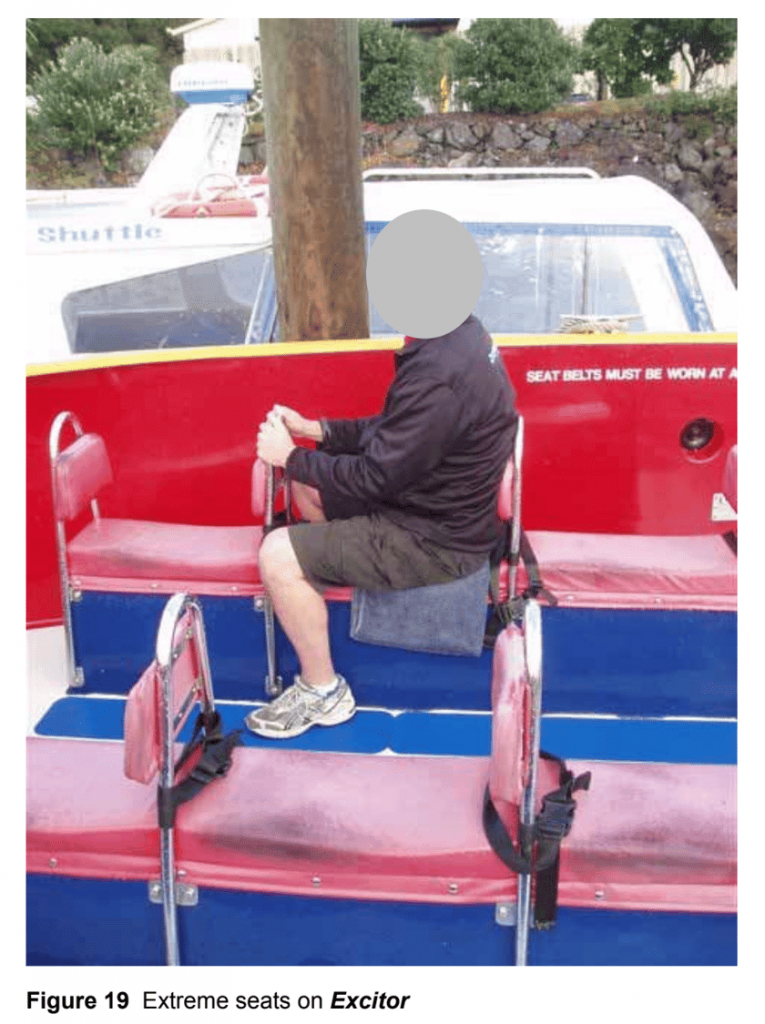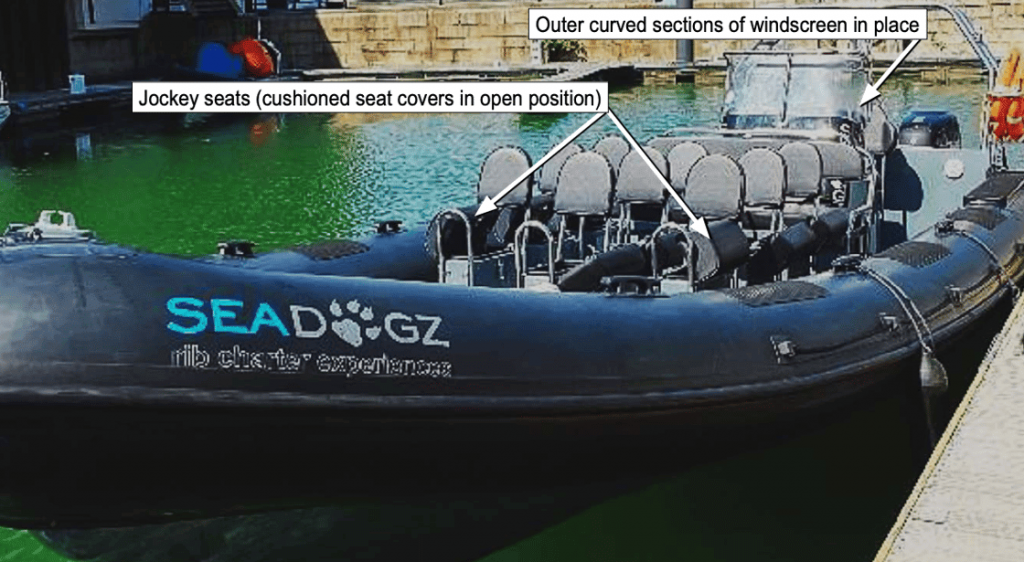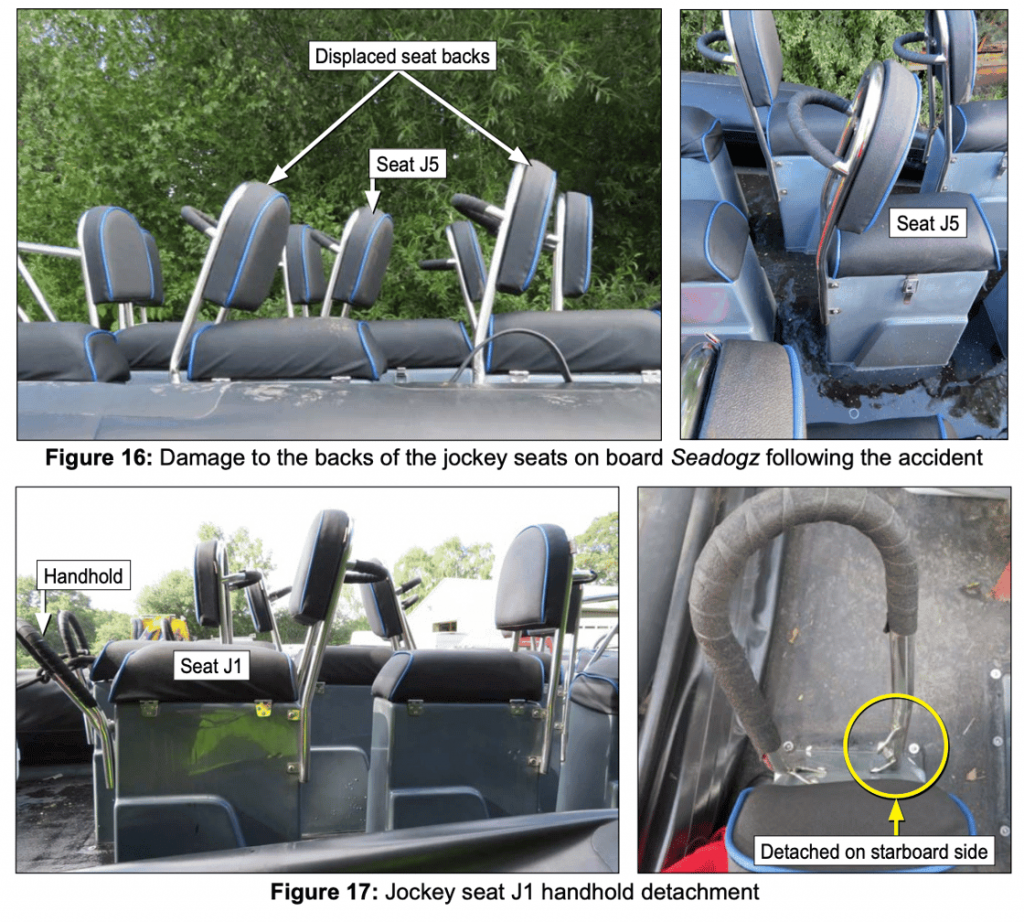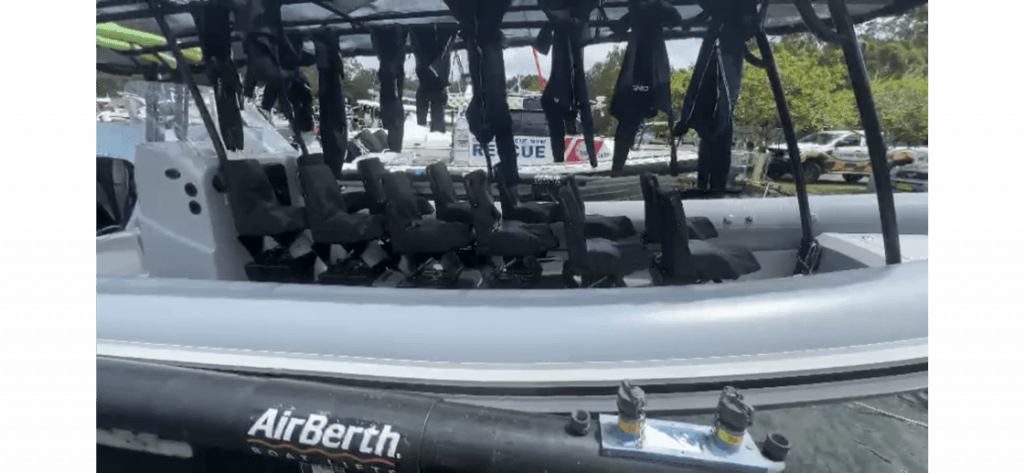Why fast tour boat operators without suspension seating will soon be extinct

Wave-slam injuries have been happening since people have been on boats. In the case of tour operators, the public is involved which increases risk factors in many ways. Reports of accidents are on the rise and there is a seemingly obvious pattern.
WAVE JUMPING AND FAST MANOEUVRING WITHOUT PROTECTION INEVITABLY HARMS PASSENGERS.
Accident reports are tough to read because of the harm suffered by victims as well as the life-long regret and financial ruin of the operators. When you know how easily it could have been prevented, you do all you can to make that known.
These questions stand out:
- Why don’t marine safety organisations across the world enforce their safety guidelines BEFORE accidents occur rather than simply reporting them AFTERWARD?
- Why do tour operators only use foam cushions and place passengers at the front of a boat where impacts are the hardest? This puts their business at severe risk.
- How can we change this?
In this article we try to answer these 3 questions with the help of examples from the UK, New Zealand and Australia; in which suspension seating could have (or already has) saved boat companies and their passengers.
Seadogz (UK)

“The tragic events that took place in ‘Southampton Water’ on the morning of 22 August 2020 have had an unimaginable impact on all of those affected by the accident. The fact that a passenger excursion on a modern rigid inflatable boat being operated in favourable conditions by an appropriately qualified and highly experienced skipper could result in such terrible consequences is difficult to comprehend.”
This is the first line of the accident report where a Southampton tour boat full of passengers hit a buoy and tragically resulted in a fatality and many severe injuries. It’s important to note that even with favourable conditions, an experienced captain and a modern boat this incident still occurred.
The passengers on this vessel were seated at the front of the boat on saddle style jockey seats (no suspensions) and the design of the seats and their layout played a large role in the injuries sustained.

Having a crash tested seat that is made to absorb impacts from all directions with shock mitigation and vibration reduction should be standard on tour vessels. Especially when…
“passengers in small high-speed craft are very vulnerable to impact and vibration injuries. In the last 15 years, the MAIB has investigated numerous accidents involving high-speed passenger craft and made various recommendations to improve the safety of this sector. However, as yet, little has been done to provide proper protection to passengers and crew from these hazards that routinely result in life-changing injury and, occasionally, death.” (Captain Andrew Moll OBE, FOREWORD)
With numerous accident reports arising, it’s mind blowing that little has been done to resolve this issue. The problem lays in the word “recommendations”.
“The manufacturer of Seadogz, Red Bay Boats Ltd, has been recommended to ensure that the design of the seats, handholds and restraints on its high-speed craft meet the latest relevant industry guidance and that the documentation provided to owners is accurate.” (Reference 1)
People’s lives are at stake and their safety can only be attained by making these “recommendations” mandatory and by enforcing them with inspections BEFORE accidents occur and penalties AFTER they occur. Examples below will show how tour operators have been financially crippled by such penalties. If the result of this horrific accident is merely a reminder about much flaunted guidelines, nothing is going to change. Operators will roll the dice to avoid the moderate cost of suspension seating and instead take the risk of being denied insurance, fined, sued and put out of business. This is why shark has tried so hard to make suspension seating as affordable as possible to remove the excuse of a high price tag and enable operators to do the right thing and stay in business at the same time.
So what would a safe passenger layout look like? A customer of ours (BlueSeafaris.com) have done a fantastic job at setting an example for passenger safety in regards to field of vision and seating.

They have put all passengers on height adjustable suspension jockey seats with flexible backrests and sensibly placed hand-holds and has even lowered the seats at the front to increase his field of vision. This eliminates the issues faced by Seadogz and at a cost and weight which was similar to regular seating. This is setting the standard for passenger care, protection and comfort. Some companies get ahead of potential law suits and passenger injury and others unfortunately learn the hard way…
Mack Attack and Excitor (New Zealand)
On the 27th of June 2009 a passenger on the 18m Excitor II vessel suffered a lower back compression fracture while on a 90 minute boat tour around the bay of Islands. She received a serious harm injury to her vertebrae when she landed heavily on her seat after she was lifted into the air due to the motion of the vessel. She was treated in hospital for a number of days before returning home for recovery.
“Maritime New Zealand (MNZ) is aware of seven other accidents that have resulted in lower back compression injuries on board one of the two current high-speed vessels operating out of Paihia in the Bay of Islands. “There have been four compression fractures on three separate accidents in 2009 alone… (reference 2)” Extra padding has been added to the seat bottoms in an attempt to reduce the impact … However, this can lead to increased risk of injury, because the individual will still be moving downwards, compressing the cushion, while the boat has landed and is travelling upwards. This results in an increased impact as the boat seat and occupant are travelling in opposite directions at the point of impact.
“Seating is as important as the hull design as it will directly interact with the passenger and can reduce the injury rate dramatically. (ref 2)” Despite this report a replacement boat Excitor III (12m) began operating in October 2010 and “in January and March 2011, passengers were injured in incidents on the boat and Maritime New Zealand stopped the boat operating” https://en.wikipedia.org/wiki/Excitor.
To summarise, this pattern of injuries continued until both tour companies were bankrupted by large fines and lawsuits. In 2018 Mack Attack was bought by a new owner and returned to service with shark suspension seats fitted and a new name. Below are the before (top) and after (bottom) images.
No further accidents have occurred to this day, which shows that these injuries (as well as bankruptcy) are avoidable with the right equipment and attitude.
Reef Ryder (Australia)
In this case it was the operators determination to renew its liability insurance which led to the installation of shark suspension seating. This enabled them to future-proof their business as well as safely protect passengers. No injuries have occurred as a result. Below are before and after pics:
While we wait for organisations around the world to take enforcement actions, it is in the hands of crew, unions and responsible boat operators to protect themselves and their customers from such health and financial risks.
Conclusion
Discussing such serious accidents is uncomfortable, but necessary to get the message across. As officially reported, little has been done to improve passenger safety. If you operate a boat, the buck stops with you and the safety of the people who board your boat is entirely your responsibility and liability. Accidents do happen and ignorance of the correct protection devices is no excuse. Seating a passenger on just a foam cushion is equivalent to putting someone on your motorbike with only a woolly hat or in your car without seatbelts. You CAN make sure that every person to leave your boat with smiles not harm by making sure they are protected in the best way possible…to reference the Paihia accident report “Seating is as important as the hull design as it will directly interact with the passenger and can reduce the injury rate dramatically.” Suspension seating is a no brainer when it comes to safety, as these examples show, injuries have been completely eliminated since installation of suspension seating. To conclude with a line from the Seadogz report, “I am therefore hoping that the maritime regulator, manufacturers and operators of small high-speed passenger craft will take the lessons from this report as a stimulus to action. As the report says, this was an accident waiting to happen. Let it be the last.”
REALITY CHECK: did we answer the 3 Questions?
A. Why don’t marine safety organisations across the world enforce their safety guidelines BEFORE accidents occur rather than simply reporting them AFTERWARD? – Legislation takes time. Cars were around for 70 years before seatbelts became mandatory and add another 30 years for airbages. This is unfortunate because boat owners typically cut expenses when possible until they realise too late that suspension seating can keep them in operation. For this reason shark is continually developing the most cost effective ways (now with FLEXpod) to optimise performance and cost of safe suspension seats.
B. Why do tour operators only use foam cushions and place passengers at the front of a boat where impacts are the hardest? This puts their business at severe risk. – Having the passengers at the front is important for a tour boat so people are able to see their surroundings better and the skipper can keep an eye on everyone from the back. However wave impacts hit the hardest at front of the boat putting passengers at risk when seated just on foam cushions. They feel fine when stationary but are an accident waiting to happen. Suspension seating can be thought of as a form of insurance or even an investment. With that instillation you will pay slightly more (or even the same in some cases) than regular seating, however with that cost comes the protection of greater future costs like fines, lawsuits and human injury. With some of the newer developments in suspension seating, it is possible to have extremely lightweight options that are low maintenance, low cost and protect your business.
C. How can we change this? – It seems as though some safety organisations haven’t been exposed to the necessity of suspension seating for tour boat operations. It is such a no brainer solution to a problem pattern that has been occurring for years. Mandatory Health and Safety regulations already exist (NSCV-F1, Directive 2002-44-EC, UKSI 2005 No. 1093) but enforcement is curretnly lacking. Sensible boat operators are leading the charge for the sake of their business and passengers. At shark we want to accelerate this by eliminating all excuses of cost, weight, size, maintenance and hassle.
One of our goals at shark (and what we believe should be an industry goal) is to have safety organisations across the globe ensure that suspension seating is compulsory for fast tour boat operators making injury inducing seating extinct.
References:
1. MAIB.(2020) – Seadogz – Very Serious Marine Casualty. Southampton UK: MAIB. Available at: https://assets.publishing.service.gov.uk/media/6579bc3d095987001295e008/2023-10-Seadogz-Report.pdf (Accessed:10/01/2024)
Mack attack and Excitor:
2. Maritime New Zealand(2009) Safety Investigation Paihia high-speed passenger boats. Wellington NZ: Maritime New Zealand. Available at: www.maritimenz.govt.nz (Accessed: 10/01/2024)
